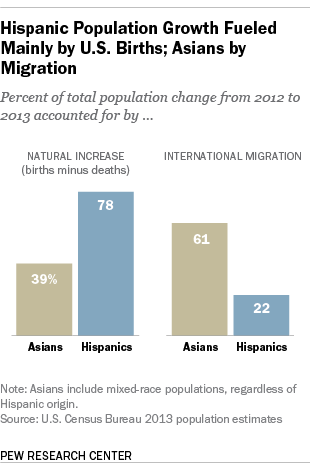The distinction of being the fastest-growing racial/ethnic group in the United States has alternated between Asians and Hispanics in recent decades. Since 2010, though, Asians have had the edge. New Census Bureau data estimate that the U.S. Hispanic population topped 54 million as of July 1, 2013, an increase of 2.1% over 2012. Meanwhile, the Asian population grew to 19.4 million, with a growth rate of 2.9%.

U.S. births have been the primary driving force behind the increase in the Hispanic population since 2000 and that trend continued between 2012 and 2013. The Census Bureau estimates that natural increase (births minus deaths) accounted for 78% of the total change in the U.S. Hispanic population from 2012 to 2013.
By comparison, growth in the Asian American population has been fueled primarily by immigration. Fully 74% of Asian adults in 2012 were foreign born according to Pew Research Center analysis of Census data, and international migration accounted for about 61% of the total change in the Asian American population from 2012 to 2013. (Asian American figures represent the population who reported their race alone or in combination with one or more races, and includes Hispanics. Hispanics are of any race.)
The different sources of population change are reflected in the demographic profiles of Asians and Hispanics. For example, the median age of Asians is 36.3, reflecting its larger share foreign born, compared with Hispanics at 28.1, reflecting the importance of U.S. births to populations growth.
Geographically, Asians and Hispanics are situated similarly across the country with majorities of each population concentrated in the west. For Hispanics, New Mexico still has the highest Hispanic population share at 47% while California has the largest overall Hispanic population (14.7 million). Texas, the second largest state by Hispanic population, saw the largest numeric increase in Hispanic population from 2012 to 2013, as it grew by 213,000 people. The Hispanic population increased the fastest in North Dakota—17% over 2012 to about 21,000 in 2013. (North Dakota boasted the highest population growth rates for every major racial and ethnic group except Native Americans and Alaskan Natives.)
California also has the largest Asian population (6.1 million) and Hawaii has the largest Asian population share (56%, the only state in which Asians are a majority). California was also home to the largest numeric increase between 2012 and 2013, with a net increase of 142,000 Asians. Just as with Hispanics, North Dakota saw the highest rate of Asian population increase between 2012 and 2013—up 8.4%.
